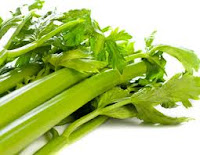CELERIAC, APIUM GRAVEOLANS VAR. RAPACEUM
Celeriac is the unpromising-looking root of celery, which is warty due to the rootlets that stem from it. If you get over its appearance you will find that it combines the flavours of celery and parsley (to which it is also related). It is a member of the Apiaceae or Umbelliferae family which makes it a relative of anise, caraway, fennel, dill, carrots and parsnips. It is known by several names such as root celery, knob celery, and turnip-rooted celery, as it does bear some resemblance to a giant turnip, although it is certainly not as attractive.
It shares the same history as celery but was cultivated for it s root in Italy Europe , and became famous in France
You can boil it, mash it, bake or roast it and deep fry it - anything you can do with a potato you can do with this unprepossessing vegetable. It’s very good mashed with potatoes and garlic. You can make a creamy vegetable soup with it for winter or use it in salads such as the one above in summer. The recipe given below is a delicious accompaniment to meat and goes well with broccoli.
 Celeriac has been used for its medicinal properties, as it helps with periods, and promoted milk flow in breast-feeding mothers, as well as being a diuretic and good for breaking down and flushing out kidney stones. It has also been used to strengthen the nervous system, as a stimulant and tonic.
Celeriac has been used for its medicinal properties, as it helps with periods, and promoted milk flow in breast-feeding mothers, as well as being a diuretic and good for breaking down and flushing out kidney stones. It has also been used to strengthen the nervous system, as a stimulant and tonic. It is fairly low in calories, but contains sodium, so you don’t need to put much salt with it when you cook it. You can bake it whole and then peel it for ease after cooking and to have a low calorie snack. The leaves can be used to flavour soups and stews and they can be eaten raw, but it is better to blanch them at least as they have a strong taste.
 |
| Celeriac strips |
 When raw the root contains a fair amount of vitamin C and it is potassium and phosphorous rich and also contains many of the B-complex vitamins although not thiamin (B1). It also has the minerals selenium, calcium, iron, zinc, copper, manganese and magnesium in it. Potassium is good for many reasons especially as it lowers blood pressure and the risk of strokes according to Harvard University Health Professional Study which also found that drinking coffee has benefits. Combined with magnesium, potassium helps men with erectile dysfunctions as it promotes the blood flow and dilates the arteries.
When raw the root contains a fair amount of vitamin C and it is potassium and phosphorous rich and also contains many of the B-complex vitamins although not thiamin (B1). It also has the minerals selenium, calcium, iron, zinc, copper, manganese and magnesium in it. Potassium is good for many reasons especially as it lowers blood pressure and the risk of strokes according to Harvard University Health Professional Study which also found that drinking coffee has benefits. Combined with magnesium, potassium helps men with erectile dysfunctions as it promotes the blood flow and dilates the arteries. If you want to grow this in your garden it goes well with French beans (green beans), leeks, tomatoes and the brassicas (cabbage, broccoli, brussel sprouts etc.). This root vegetable only arrived in the US
CELERIAC SIDE DISH
3 large celeriac, peeled and cut into thin strips
water and lemon juice combined in a bowl
juice of ½ lemon
olive oil
½ cup of any one or two of the following herbs:-
salt and freshly ground black pepper to taste
Parmesan cheese freshly grated to serve
Method
As you peel and cut the celeriac into strips, put them in the bowl of lemon water.
Bring a saucepan of water to the boil and add the celeriac and the juice of ½ lemon. Bring back to the boil and then reduce the heat and simmer for about 30 minutes until the celeriac is tender, but not mushy.
Remove from the heat and drain and then return the celeriac to the pan along with the olive oil and herbs of your choice and salt if necessary and freshly ground black pepper.
Heat through and serve.
This has Taste and is a Treat.



















































